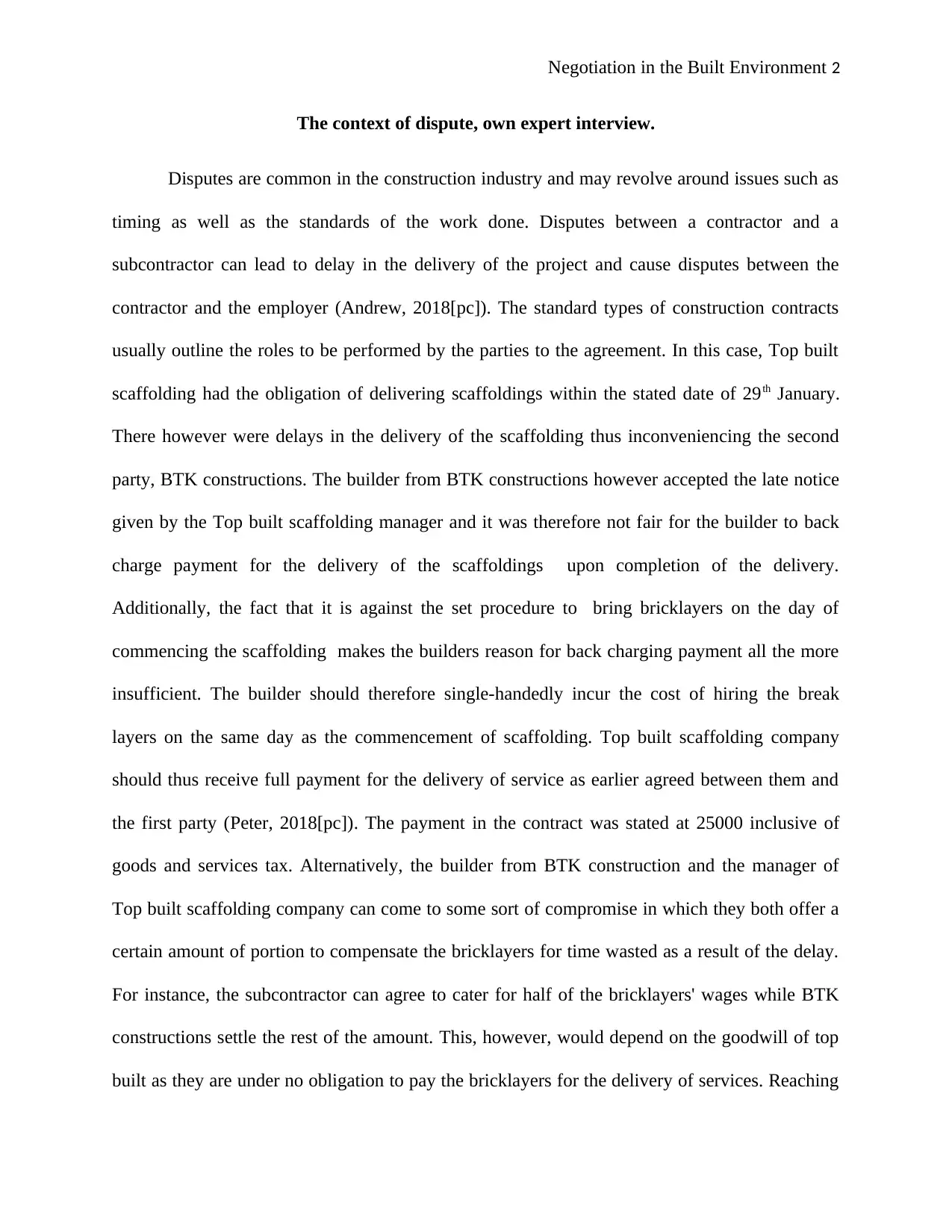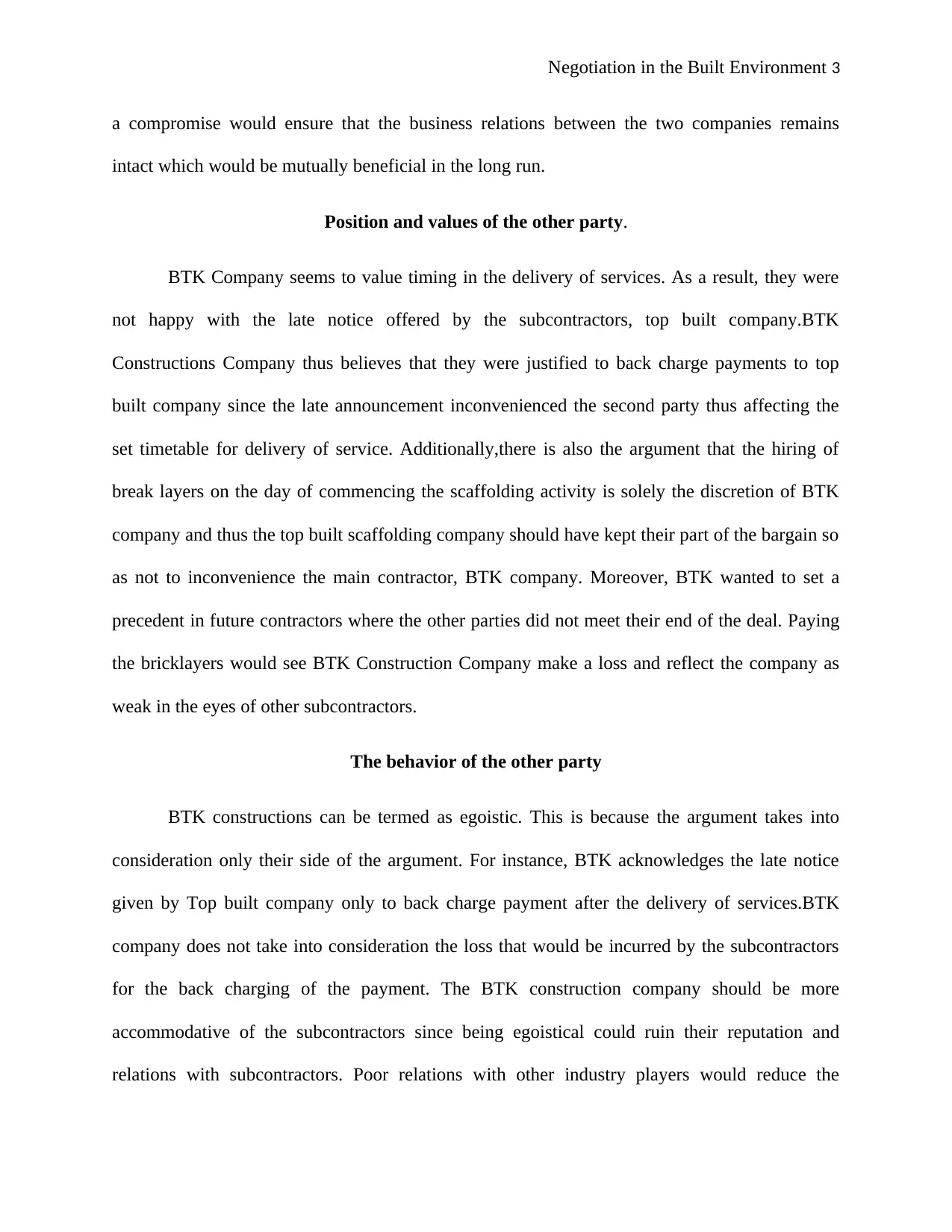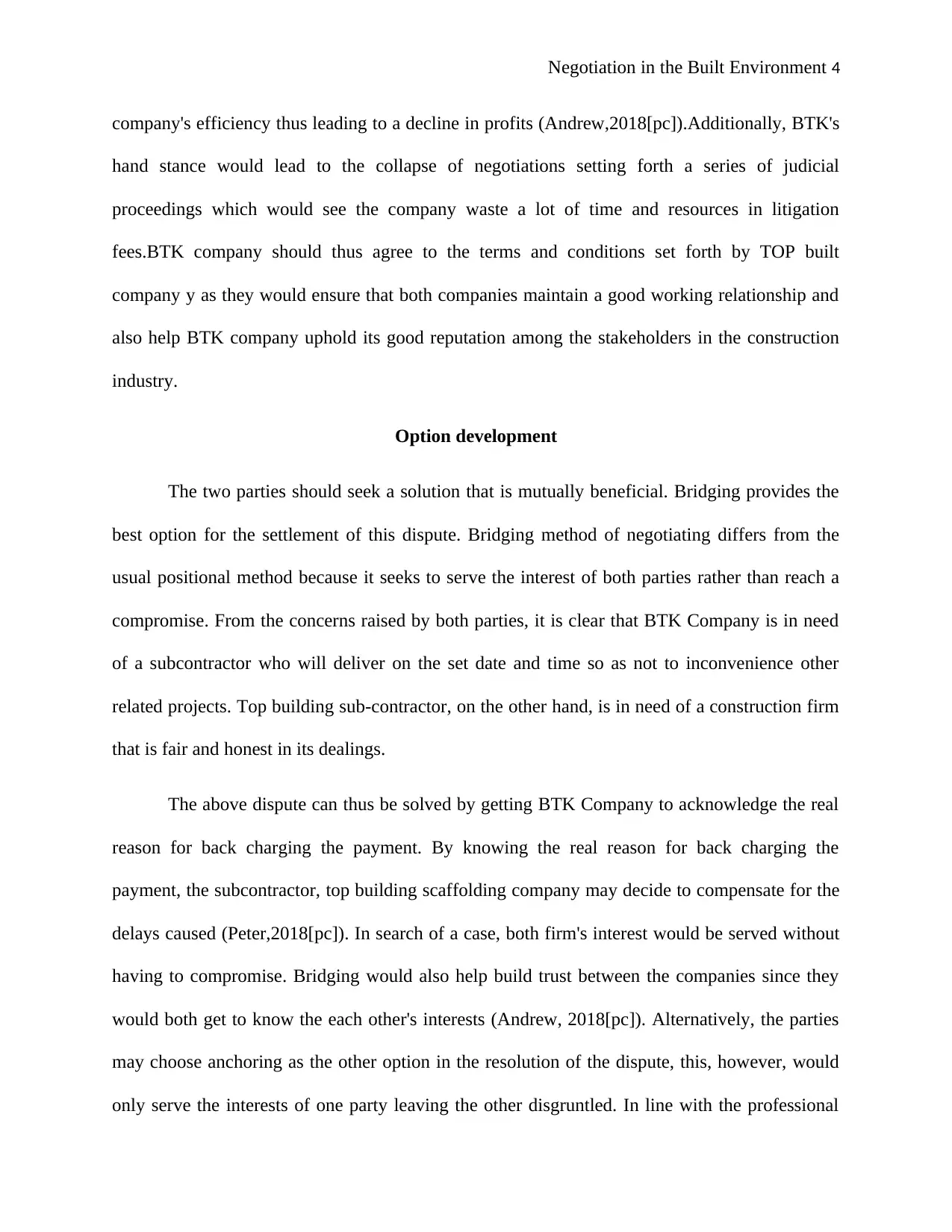Negotiation in the Built Environment: Strategies & Dispute Analysis
VerifiedAdded on 2023/06/11
|6
|1189
|179
Report
AI Summary
This report examines a negotiation scenario within the built environment, specifically a dispute between Top Built Scaffolding and BTK Constructions regarding delayed scaffolding delivery and subsequent back charges. It analyzes the positions and values of both parties, highlighting BTK's emphasis on timely service delivery and Top Built's need for fair dealings. The report critiques BTK's egoistic behavior and suggests a bridging approach to negotiation, focusing on mutually beneficial solutions rather than compromise. Alternative options like anchoring are considered, but the bridging method is favored for its potential to build trust and address the underlying interests of both companies. The report emphasizes the importance of maintaining good working relationships and upholding a positive reputation within the construction industry. Desklib offers more solved assignments.

Negotiation in the Built Environment 1
NEGOTIATION IN THE BUILT ENVIRONMENT
By (Name)
Course
Professor’s name
University name
City, State
Date of submission
NEGOTIATION IN THE BUILT ENVIRONMENT
By (Name)
Course
Professor’s name
University name
City, State
Date of submission
Paraphrase This Document
Need a fresh take? Get an instant paraphrase of this document with our AI Paraphraser

Negotiation in the Built Environment 2
The context of dispute, own expert interview.
Disputes are common in the construction industry and may revolve around issues such as
timing as well as the standards of the work done. Disputes between a contractor and a
subcontractor can lead to delay in the delivery of the project and cause disputes between the
contractor and the employer (Andrew, 2018[pc]). The standard types of construction contracts
usually outline the roles to be performed by the parties to the agreement. In this case, Top built
scaffolding had the obligation of delivering scaffoldings within the stated date of 29th January.
There however were delays in the delivery of the scaffolding thus inconveniencing the second
party, BTK constructions. The builder from BTK constructions however accepted the late notice
given by the Top built scaffolding manager and it was therefore not fair for the builder to back
charge payment for the delivery of the scaffoldings upon completion of the delivery.
Additionally, the fact that it is against the set procedure to bring bricklayers on the day of
commencing the scaffolding makes the builders reason for back charging payment all the more
insufficient. The builder should therefore single-handedly incur the cost of hiring the break
layers on the same day as the commencement of scaffolding. Top built scaffolding company
should thus receive full payment for the delivery of service as earlier agreed between them and
the first party (Peter, 2018[pc]). The payment in the contract was stated at 25000 inclusive of
goods and services tax. Alternatively, the builder from BTK construction and the manager of
Top built scaffolding company can come to some sort of compromise in which they both offer a
certain amount of portion to compensate the bricklayers for time wasted as a result of the delay.
For instance, the subcontractor can agree to cater for half of the bricklayers' wages while BTK
constructions settle the rest of the amount. This, however, would depend on the goodwill of top
built as they are under no obligation to pay the bricklayers for the delivery of services. Reaching
The context of dispute, own expert interview.
Disputes are common in the construction industry and may revolve around issues such as
timing as well as the standards of the work done. Disputes between a contractor and a
subcontractor can lead to delay in the delivery of the project and cause disputes between the
contractor and the employer (Andrew, 2018[pc]). The standard types of construction contracts
usually outline the roles to be performed by the parties to the agreement. In this case, Top built
scaffolding had the obligation of delivering scaffoldings within the stated date of 29th January.
There however were delays in the delivery of the scaffolding thus inconveniencing the second
party, BTK constructions. The builder from BTK constructions however accepted the late notice
given by the Top built scaffolding manager and it was therefore not fair for the builder to back
charge payment for the delivery of the scaffoldings upon completion of the delivery.
Additionally, the fact that it is against the set procedure to bring bricklayers on the day of
commencing the scaffolding makes the builders reason for back charging payment all the more
insufficient. The builder should therefore single-handedly incur the cost of hiring the break
layers on the same day as the commencement of scaffolding. Top built scaffolding company
should thus receive full payment for the delivery of service as earlier agreed between them and
the first party (Peter, 2018[pc]). The payment in the contract was stated at 25000 inclusive of
goods and services tax. Alternatively, the builder from BTK construction and the manager of
Top built scaffolding company can come to some sort of compromise in which they both offer a
certain amount of portion to compensate the bricklayers for time wasted as a result of the delay.
For instance, the subcontractor can agree to cater for half of the bricklayers' wages while BTK
constructions settle the rest of the amount. This, however, would depend on the goodwill of top
built as they are under no obligation to pay the bricklayers for the delivery of services. Reaching

Negotiation in the Built Environment 3
a compromise would ensure that the business relations between the two companies remains
intact which would be mutually beneficial in the long run.
Position and values of the other party.
BTK Company seems to value timing in the delivery of services. As a result, they were
not happy with the late notice offered by the subcontractors, top built company.BTK
Constructions Company thus believes that they were justified to back charge payments to top
built company since the late announcement inconvenienced the second party thus affecting the
set timetable for delivery of service. Additionally,there is also the argument that the hiring of
break layers on the day of commencing the scaffolding activity is solely the discretion of BTK
company and thus the top built scaffolding company should have kept their part of the bargain so
as not to inconvenience the main contractor, BTK company. Moreover, BTK wanted to set a
precedent in future contractors where the other parties did not meet their end of the deal. Paying
the bricklayers would see BTK Construction Company make a loss and reflect the company as
weak in the eyes of other subcontractors.
The behavior of the other party
BTK constructions can be termed as egoistic. This is because the argument takes into
consideration only their side of the argument. For instance, BTK acknowledges the late notice
given by Top built company only to back charge payment after the delivery of services.BTK
company does not take into consideration the loss that would be incurred by the subcontractors
for the back charging of the payment. The BTK construction company should be more
accommodative of the subcontractors since being egoistical could ruin their reputation and
relations with subcontractors. Poor relations with other industry players would reduce the
a compromise would ensure that the business relations between the two companies remains
intact which would be mutually beneficial in the long run.
Position and values of the other party.
BTK Company seems to value timing in the delivery of services. As a result, they were
not happy with the late notice offered by the subcontractors, top built company.BTK
Constructions Company thus believes that they were justified to back charge payments to top
built company since the late announcement inconvenienced the second party thus affecting the
set timetable for delivery of service. Additionally,there is also the argument that the hiring of
break layers on the day of commencing the scaffolding activity is solely the discretion of BTK
company and thus the top built scaffolding company should have kept their part of the bargain so
as not to inconvenience the main contractor, BTK company. Moreover, BTK wanted to set a
precedent in future contractors where the other parties did not meet their end of the deal. Paying
the bricklayers would see BTK Construction Company make a loss and reflect the company as
weak in the eyes of other subcontractors.
The behavior of the other party
BTK constructions can be termed as egoistic. This is because the argument takes into
consideration only their side of the argument. For instance, BTK acknowledges the late notice
given by Top built company only to back charge payment after the delivery of services.BTK
company does not take into consideration the loss that would be incurred by the subcontractors
for the back charging of the payment. The BTK construction company should be more
accommodative of the subcontractors since being egoistical could ruin their reputation and
relations with subcontractors. Poor relations with other industry players would reduce the
⊘ This is a preview!⊘
Do you want full access?
Subscribe today to unlock all pages.

Trusted by 1+ million students worldwide

Negotiation in the Built Environment 4
company's efficiency thus leading to a decline in profits (Andrew,2018[pc]).Additionally, BTK's
hand stance would lead to the collapse of negotiations setting forth a series of judicial
proceedings which would see the company waste a lot of time and resources in litigation
fees.BTK company should thus agree to the terms and conditions set forth by TOP built
company y as they would ensure that both companies maintain a good working relationship and
also help BTK company uphold its good reputation among the stakeholders in the construction
industry.
Option development
The two parties should seek a solution that is mutually beneficial. Bridging provides the
best option for the settlement of this dispute. Bridging method of negotiating differs from the
usual positional method because it seeks to serve the interest of both parties rather than reach a
compromise. From the concerns raised by both parties, it is clear that BTK Company is in need
of a subcontractor who will deliver on the set date and time so as not to inconvenience other
related projects. Top building sub-contractor, on the other hand, is in need of a construction firm
that is fair and honest in its dealings.
The above dispute can thus be solved by getting BTK Company to acknowledge the real
reason for back charging the payment. By knowing the real reason for back charging the
payment, the subcontractor, top building scaffolding company may decide to compensate for the
delays caused (Peter,2018[pc]). In search of a case, both firm's interest would be served without
having to compromise. Bridging would also help build trust between the companies since they
would both get to know the each other's interests (Andrew, 2018[pc]). Alternatively, the parties
may choose anchoring as the other option in the resolution of the dispute, this, however, would
only serve the interests of one party leaving the other disgruntled. In line with the professional
company's efficiency thus leading to a decline in profits (Andrew,2018[pc]).Additionally, BTK's
hand stance would lead to the collapse of negotiations setting forth a series of judicial
proceedings which would see the company waste a lot of time and resources in litigation
fees.BTK company should thus agree to the terms and conditions set forth by TOP built
company y as they would ensure that both companies maintain a good working relationship and
also help BTK company uphold its good reputation among the stakeholders in the construction
industry.
Option development
The two parties should seek a solution that is mutually beneficial. Bridging provides the
best option for the settlement of this dispute. Bridging method of negotiating differs from the
usual positional method because it seeks to serve the interest of both parties rather than reach a
compromise. From the concerns raised by both parties, it is clear that BTK Company is in need
of a subcontractor who will deliver on the set date and time so as not to inconvenience other
related projects. Top building sub-contractor, on the other hand, is in need of a construction firm
that is fair and honest in its dealings.
The above dispute can thus be solved by getting BTK Company to acknowledge the real
reason for back charging the payment. By knowing the real reason for back charging the
payment, the subcontractor, top building scaffolding company may decide to compensate for the
delays caused (Peter,2018[pc]). In search of a case, both firm's interest would be served without
having to compromise. Bridging would also help build trust between the companies since they
would both get to know the each other's interests (Andrew, 2018[pc]). Alternatively, the parties
may choose anchoring as the other option in the resolution of the dispute, this, however, would
only serve the interests of one party leaving the other disgruntled. In line with the professional
Paraphrase This Document
Need a fresh take? Get an instant paraphrase of this document with our AI Paraphraser

Negotiation in the Built Environment 5
codes, BTK Company would remain the disgruntled party since they lied about bricklayers being
the reason for back charging whereas the real reason was that they were trying to earn
compensation for the delays in putting up the scaffolding.
codes, BTK Company would remain the disgruntled party since they lied about bricklayers being
the reason for back charging whereas the real reason was that they were trying to earn
compensation for the delays in putting up the scaffolding.

Negotiation in the Built Environment 6
References
Andrew Hickman. (Constructions lawyer.). Else Solicitors International law firm. Personal
communication (online charts) on 2nd June 2018.
Peter Fenn (Author, Conflict, and disputes in Construction) Personal communication on 2nd
June 2018 at Waratah Street Cronulla, Sydney Australia
References
Andrew Hickman. (Constructions lawyer.). Else Solicitors International law firm. Personal
communication (online charts) on 2nd June 2018.
Peter Fenn (Author, Conflict, and disputes in Construction) Personal communication on 2nd
June 2018 at Waratah Street Cronulla, Sydney Australia
⊘ This is a preview!⊘
Do you want full access?
Subscribe today to unlock all pages.

Trusted by 1+ million students worldwide
1 out of 6
Your All-in-One AI-Powered Toolkit for Academic Success.
+13062052269
info@desklib.com
Available 24*7 on WhatsApp / Email
![[object Object]](/_next/static/media/star-bottom.7253800d.svg)
Unlock your academic potential
Copyright © 2020–2025 A2Z Services. All Rights Reserved. Developed and managed by ZUCOL.